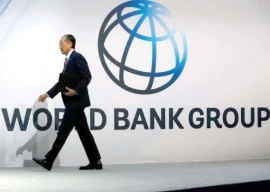
The federal government on Tuesday released data on the sorry state of Pakistan’s public debt, revealing that debt burden was Rs10.4 trillion higher than the legally allowed limit and that many risks have increased in the last fiscal year – making the burden unsustainable.
The Debt Policy Statement 2023 showed how badly the country’s debt had been managed during fiscal year 2021-22. The statement was released with a delay against a timeline set under the Fiscal Responsibility and Debt Limitation Act of 2005.
During FY 2021-22, Pakistan’s debt to GDP ratio stood at 73.5% at the end of June – higher than the 58% threshold imposed by the Fiscal Responsibility and Debt Limitation (FRDL) Act, admitted the finance ministry in its statement.
The 58% limit, considered sustainable, was breached by 15.5% of the GDP or Rs10.4 trillion. Total public debt as of June last year was Rs51.1 trillion, which under the law should have been Rs40.7 trillion. This could have helped the government save the additional interest costs on this debt.
The finance ministry stated that the threshold was breached mainly due to adverse exchange rate movement on account of the rupee depreciating against foreign currencies. Of the Rs9.4 trillion net increases in public debt, a sum of Rs3.8 trillion, or 40.3%, was caused by currency devaluation, according to the ministry. The rupee depreciated by around 30% against the US Dollar during the year which led to an increase in external public debt when reported in Pakistani rupee (PKR) terms.
Primary deficit and interest expenses were the two other reasons for this surge in public debt during the last fiscal year.
Every successive government has violated the FRDL Act despite it having been amended multiple times to change the goalposts. Yet, there has not been much focus on addressing the reasons causing higher public debt.
The report showed that the external public debt was $88.8 billion at end-June 2022, witnessing a net increase of around $2.4 billion during the year. Pakistan’s external debt is derived from four key sources; around 48% coming from multilateral loans, 30% from bilateral loans, 9% from Eurobonds and 13% from commercial loans.
The cost of interest payments also increased from $1.5 billion to $2 billion due to higher debt obligations.
The statement showed that the Finance Ministry badly failed in ensuring the debt sustainability of the country by reducing the currency risks, refinancing risks and interest rate risks.
The report showed that the share of external debt in total public debt increased from 34% in the preceding fiscal year to 37% in the last year, heightening currency risks at a time when the rupee is sinking and foreign countries are not giving loans.
“Large external payments in the wake of low foreign exchange reserves can pose liquidity problems and even destabilise the exchange rate which in turn can increase the burden of external loans measured in local currency,” stated the ministry.
The average time of maturity for domestic loans remained unchanged at 3.5 years, but below the target of 4 years. This, too, is risky and has kept the country dependent on commercial banks out to exploit the situation.
The average maturity of external debt, however, dipped from an already low level of six years and eight months to just six years and two months. This is even lower than the minimum threshold and is causing refinancing risks that have kept the country at the mercy of foreign creditors.
According to the finance ministry, “The decline in the average time of maturity of external debt needs to be carefully analysed and addressed.”
In recent years, the government has borrowed significant amounts by raising debt from commercial sources. Most of the bilateral loans obtained in recent years also had relatively shorter maturities. A combination of the above has resulted in lower Average Time to Maturity (ATM)
of external debt, according to the ministry. In yet another significant deterioration, fixed rate debt reduced from 30% to 26%, increasing interest rate risks. This is coming at a time when the central bank is already mulling a significant increase in interest rates.
For the month of February, and in the coming months, inflation will remain around 28 to 30%, according to the finance ministry –indicating huge negative real interest rates.
“Due to high borrowing needs, and a high and rising domestic interest rate environment during the second half of FY 2021- 22, larger amounts were raised by issuing floating-rate debt rather than fixed rate debt,” said the finance ministry, adding that the share of fixed rate debt in government securities fell below the target set for FY 2021-22. Gross financing needs as a percentage of GDP, however, decreased from 28% to 26% due to an inflation-bloated nominal increase in the size of the economy.
The share of floating interest rate domestic debt increased from 60% to 64% – poisonous during times when interest rates are peaking to new historic levels. As of June 2022, of the Rs31 trillion domestic debt, a sum of Rs19.8 trillion had been borrowed on floating interest rates.
Similarly, as against the previous level of 17%, as much as 24% or $21.3 billion government external public debt is maturing in less than one year – a voluminous figure that has now exposed the country to high risk of sovereign default.
Published in The Express Tribune, March 1st, 2023.
Like Business on Facebook, follow @TribuneBiz on Twitter to stay informed and join in the conversation.

1732013245-0/now-you-see-me-(1)1732013245-0-405x300.webp)
1730959638-0/trump-(19)1730959638-0-165x106.webp)


















COMMENTS
Comments are moderated and generally will be posted if they are on-topic and not abusive.
For more information, please see our Comments FAQ